
Polskie Radio Spółka Akcyjna is Poland's national public-service radio broadcasting organization, owned by the State Treasury of Poland.
Vehicle registration plates of Poland indicate the region of registration of the vehicle given the number plate.
The history of rail transport in Poland dates back to the first half of the 19th century when railways were built under Prussian, Russian, and Austrian rule. Of course, "divided Poland" in the 19th century was the territory of the former Polish–Lithuanian Commonwealth and not that one of today's Republic of Poland. After Polish independence was declared on 11 November 1918, the independent Polish state administered its own railways until control was surrendered to German and Soviet occupiers during World War II.
Polska Liga Koszykówki (PLK) is a professional men's club basketball league in Poland. It constitutes the first and highest-tier level of the Polish league pyramid. The winning team of the final round are crowned the Polish Champions of that season. It began in 1947–48, with the name of I Liga, and was originally organized by the Polish Basketball Federation. The league changed to its current form, beginning with the 1997–98 season, after the Polska Liga Koszykówki SA, PLK SA took control over the league. In 2000–01 season the league turned professional.
The Polskie Towarzystwo Socjologiczne (PTS) (Polish Sociological Association) is the main professional organization of sociologists in Poland. The PTS defines its mission as "supporting the development of sociology and popularizing sociological knowledge within society".

The June 1976 protests were a series of protests and demonstrations in the Polish People's Republic that took place after Prime Minister Piotr Jaroszewicz revealed the plan for a sudden increase in the price of many basic commodities, particularly food. Prices in Poland were at that time fixed, and controlled by the government, which was falling into increasing debt.
The subdivisions of the Polish People's Republic changed several times from the Republic's inception in 1946 to the latest revision in 1999. The first subdivisions of the Republic involved the territories that were acquired in the west after World War II. They were subsequently reformed in 1946, 1950, 1957 and 1975. The 1975 division survived the fall of communism in 1990. The current administrative subdivisions were finalised in 1999. While they closely resemble the 1945–75 scheme, they have different names since the Communists tended to simply name the voivodeships after their capitals, whereas the current ones use more historical names. In some cases, there were border adjustments.
Football Junior Championships of Poland Under-19 is a competition which started in the summer of 1936.

In the NUTS codes of Poland (PL), the three levels are:
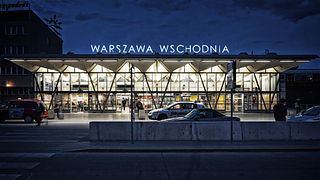
Warszawa Wschodnia, in English Warsaw East, is one of the most important railway stations in Warsaw, Poland. Its more official name is Warszawa Wschodnia Osobowa. It is located on the eastern side of the Vistula river, on the border of the Praga-Północ and Praga-Południe districts, on the Warsaw Cross-City Line. It serves all trains passing through the larger Warszawa Centralna and Śródmieście stations which stop or terminate at Wschodnia station. It is one of the busiest railway stations in Poland, with over 800 daily trains.

The architecture of Poland includes modern and historical monuments of architectural and historical importance.

Kutno railway station is a railway station in Kutno, in the Łódź Voivodeship, Poland. The station opened in 1861 and is located on the Warsaw–Kunowice railway, Łódź–Kutno railway, Kutno–Piła railway and Kutno–Brodnica railway. The train services are operated by PKP, Koleje Mazowieckie, Koleje Wielkopolskie, Łódzka Kolej Aglomeracyjna and Polregio.

Poznań Główny, anglicised to Poznan Main, is the chief railway station for the city of Poznań, Poland's fifth-largest city, and capital of the Greater Poland Province.
Poland Ekstraklasa, meaning "Extra Class" in Polish, named PKO Bank Polski Ekstraklasa since the 2019–20 season due to its sponsorship by PKO Bank Polski, is the top Polish professional league for men's association football teams.
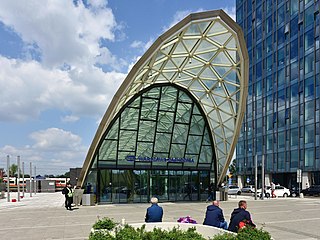
Warszawa Zachodnia station, in English Warsaw West, is a railway and long-distance bus station in Warsaw, Poland on the border of Ochota and Wola districts. The railway station is the westernmost terminus of the Warsaw Cross-City Line. It serves trains from PKP Intercity, Polregio, Koleje Mazowieckie, Szybka Kolej Miejska and Warszawska Kolej Dojazdowa as well as international trains passing through Warsaw. It is one of the busiest railway stations in Poland, with over 800 daily trains.
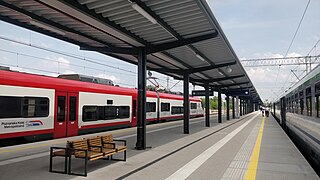
Konin railway station is a railway station in Konin, in the Greater Poland Voivodeship, Poland. The station opened in 1921 and is located on the Warsaw–Kunowice railway and Konin–Kazimierz Biskupi railway. The train services are operated by PKP and Koleje Wielkopolskie.
The Central Junior League is the highest level in Polish Under-19 football. Created in mid-2013, it replaced Mloda Ekstraklasa. The winner of the CLJ advances to the UEFA Youth League.
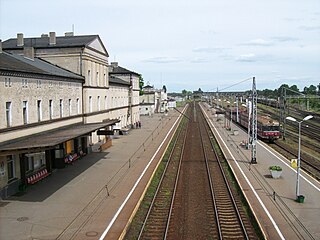
Krzyż railway station is a railway station serving the town of Krzyż Wielkopolski, in the Greater Poland Voivodeship, Poland. The station opened in 1851 and is located on the Tczew–Kostrzyn railway, Poznań–Szczecin railway and now closed Wałcz–Krzyż railway. The train services are operated by PKP, Przewozy Regionalne.
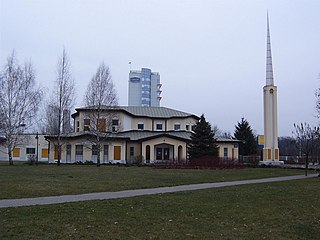
The Church of Jesus Christ of Latter-day Saints in Poland refers to the Church of Jesus Christ of Latter-day Saints and its members in Poland. At year-end 1989, there were less than 100 members in Poland. In 2021, there were 2,089 members in 11 congregations.












